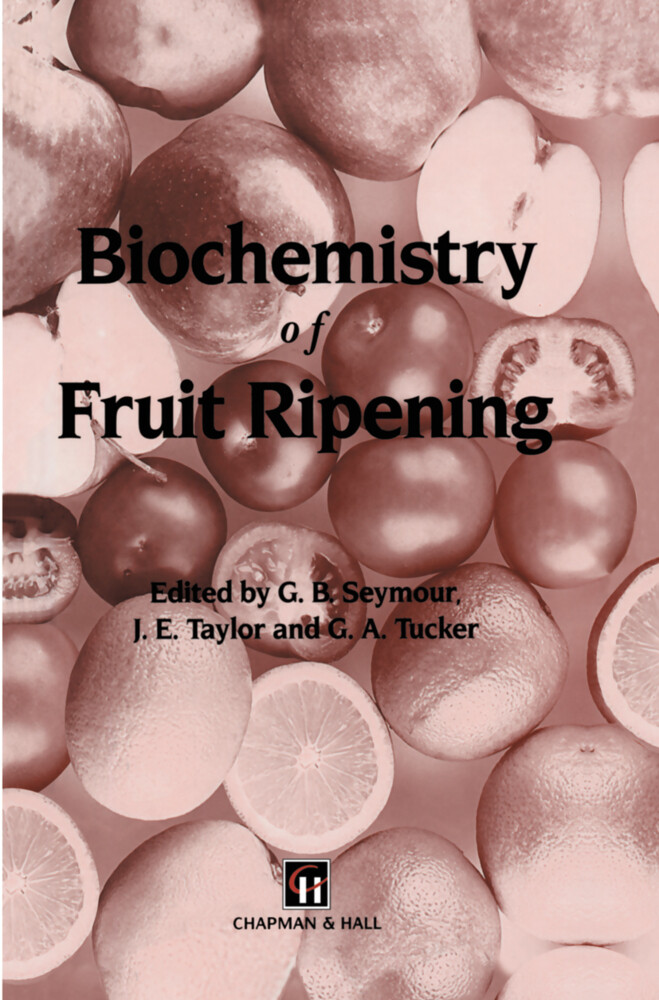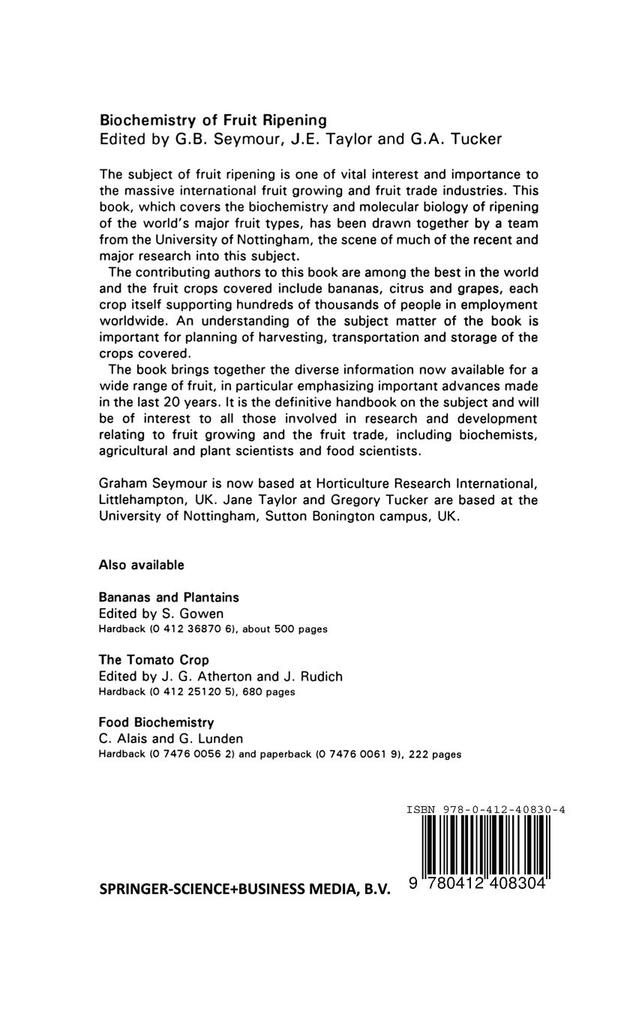
Zustellung: Mi, 23.07. - Sa, 26.07.
Versand in 7 Tagen
VersandkostenfreiBestellen & in Filiale abholen:
It is over 20 years since the publication of A. c. Hulme's two volume text on The Biochemistry of Fruits and thei. r Products. Whilst the bulk of the information contained in that text is still relevant it is true to say that our understanding of the biochemical and genetic mech
Inhaltsverzeichnis
1 Introduction. - 1. 1 Respiration and energy. - 1. 2 Flavour changes. - 1. 3 Colour changes. - 1. 4 Texture changes. - 1. 5 Control of ripening. - 1. 6 Conclusions. - References. - 2 Avocado. - 2. 1 Introduction. - 2. 2 Physiology. - 2. 3 Biochemistry. - 2. 4 Gene expression during fruit ripening. - References. - 3 Banana. - 3. 1 Introduction. - 3. 2 Ethylene production and respiration. - 3. 3 Carbohydrate metabolism. - 3. 4 Pigment changes. - 3. 5 Cell wall changes. - 3. 6 Phenolic compounds. - 3. 7 Organic acid and amino acid metabolism. - 3. 8 Production of volatile compounds. - 3. 9 Lipids. - 3. 10 Other changes. - 3. 11 Concluding remarks. - References. - 4 Citrus fruit. - 4. 1 Commercial importance of citrus fruit. - 4. 2 Taxonomy and cultivars. - 4. 3 Harvest. - 4. 4 Postharvest. - 4. 5 General physiology. - 4. 6 Biochemical changes during development, ripening and storage. - 4. 7 Citrus biotechnology. - References. - 5 Exotics. - 5. 1 Introduction. - 5. 2 Persimmon. - 5. 3 Lychee. - 5. 4 Guava. - 5. 5 Annona species. - 5. 6 Carambola. - 5. 7 Tamarillo. -5. 8 Passion fruit. - 5. 9 Mangosteen. - 5. 10 Feijoa. - 5. 11 Rambutan. - References. - 6 Grape. - 6. 1 Origin and distribution. - 6. 2 Grape berry morphology. - 6. 3 Fruit growth and development. - 6. 4 Growth regulation - phytohormones. - 6. 5 Postharvest physiology. - 6. 6 Handling and storage. - 6. 7 Compositional changes. - 6. 8 Phenolic compounds. - 6. 9 Aroma. - 6. 10 Cell wall metabolism. - References. - 7 Kiwifruit. - 7. 1 Introduction. - 7. 2 Physiology. - 7. 3 Biochemistry. - 7. 4 Pathways and enzymes. - 7. 5 Regulation of ripening. - 7. 6 Future prospects. - References. - 8 Mango. - 8. 1 Introduction. - 8. 2 Fruit development and harvest maturity. - 8. 3 Ripening processes. - References. - 9 Melon. - 9. 1 Introduction. - 9. 2 Botany. - 9. 3 Physiological changes during development and ripening. - 9. 4 Biochemical changes during development and ripening. - 9. 5 Postharvest diseases and disorders. - 9. 6 Genetic improvement. - References. - 10 Pineapple and papaya. - 10. 1 The pineapple an introduction. - 10. 2 Pineapple physiology and biochemistry. - 10. 3 Papaya an introduction. - 10. 4 Papaya physiology. - 10. 5 Papaya biochemistry. - References. - 11 Pome fruits. - 11. 1 Introduction. - 11. 2 Physiology. - 11. 3 Biochemistry. - 11. 4 Regulation. - References. - 12 Soft fruit. - 12. 1 Introduction. - 12. 2 Physiology. - 12. 3 Biochemistry. - 12. 4 Metabolic pathways. - 12. 5 Hormonal regulation of development and ripening. - 12. 6 Gene expression during development and ripening. - References. - 13 Stone fruit. - 13. 1 Introduction. - 13. 2 The Prunus species and their origins. - 13. 3 Peaches and nectarines (P. persica). - 13. 4 Plum (P. domestica). - 13. 5 Mume, or Japanese apricot (P. mume). - 13. 6 Apricot (P. armeniaca). - 13. 7 Almond (P. amygdalus). - 13. 8 Tart or sour cherry (P. cerasus). - 13. 9 Sweet cherry (P. avium). - 13. 10 Olive (Olea europaea L). - References. - 14 Tomato. - 14. 1 Introduction. - 14. 2 History and classification. - 14. 3 Tomato production. - 14. 4 Fruit quality. - 14. 5 Ethylene synthesis and action. - 14. 6 Temperature stresses and their effects on ripening. - 14. 7 The mechanism of tomato ripening. - 14. 8 Non-ripening mutants. - 14. 9 Cloning and characterization ripening-related mRNAs. - 14. 10 Polygalacturonase and its role in texture change. - 14. 11 Tomato genetic engineering. - 14. 12 Control of fruit-specific and ripening-specific gene expression. - References. - Glossary of botanical names.
Produktdetails
Erscheinungsdatum
30. April 1993
Sprache
englisch
Auflage
1993
Seitenanzahl
472
Herausgegeben von
G. B. Seymour, J. E. Taylor, Gregory A. Tucker, G. A. Tucker
Verlag/Hersteller
Produktart
gebunden
Abbildungen
XI, 454 p.
Gewicht
956 g
Größe (L/B/H)
241/160/34 mm
ISBN
9780412408304
Entdecken Sie mehr
Pressestimmen
. . . the Biochemistry of Fruit Ripening is aimed at all those involved in planning, harvesting, transport and storage of fruit. . . . to emphasise in particular the advances made in the last 20 years. - Comment; . . . 400 well documented pages. . . In summary, this book should allow a researcher or teacher unfamiliar with this area to assemble biochemical information concerning a wide range of individual fruits efficiently - Plant Science
Bewertungen
0 Bewertungen
Es wurden noch keine Bewertungen abgegeben. Schreiben Sie die erste Bewertung zu "Biochemistry of Fruit Ripening" und helfen Sie damit anderen bei der Kaufentscheidung.










